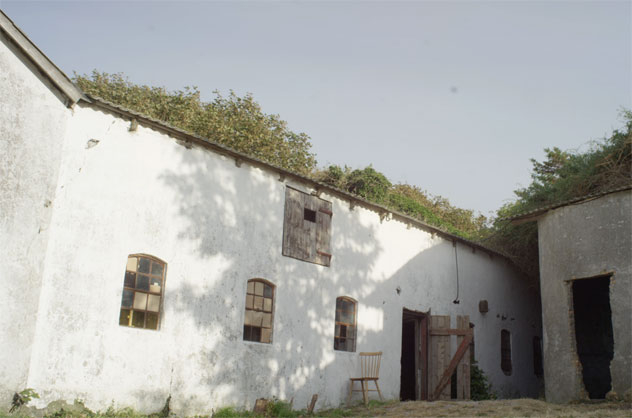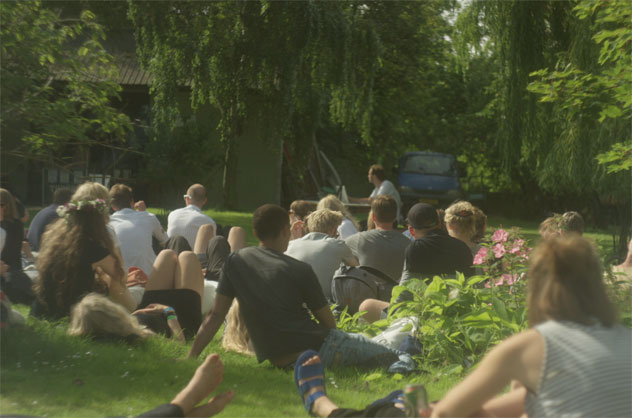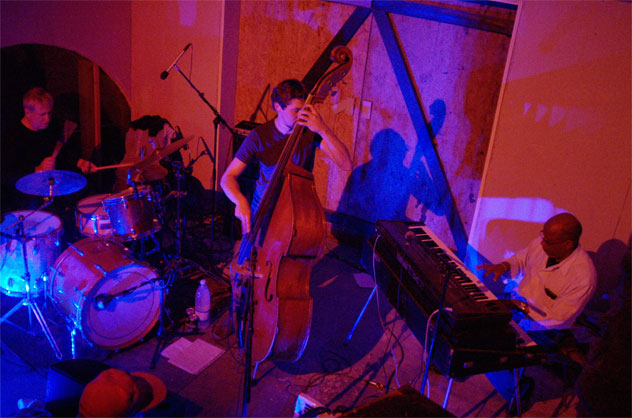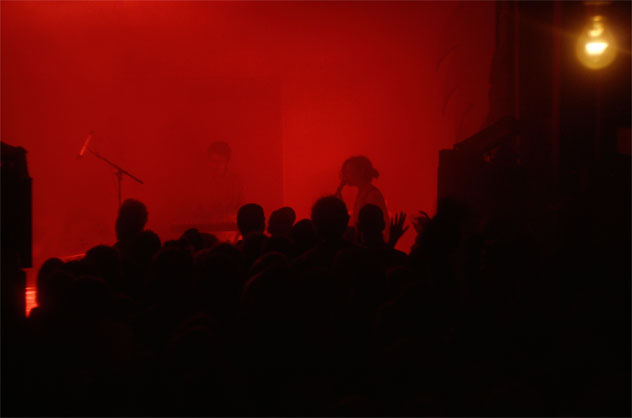- It's mid-afternoon on the island of Sejerø, and a guy in a faintly satanic mask is shooting arrows into a target propped on bales of hay. Each thunk, captured on a hidden microphone, whips up a cloud of feedback from a table of effects pedals operated by his bandmate. Behind them, swallows dart in and out of a dilapidated barn, pursuing insects through the brisk sea air. When the archer has emptied his quiver the audience of about a hundred, lounging on the grass, applauds mildly. This is Sejerø festival, and there's nothing else quite like it.
Situated 90 minutes' drive and an hour's ferry west of Copenhagen, Sejerø is an island of peaceful cornfields and "for sale" signs, with a population of 300 and an average age pushing 60. While the island has been slowly dying, the festival which takes its name is in rude health. About half a decade ago, two Copenhageners, Thomas Buhl-Wiggers and Kasper Lynge Jensen, found a derelict plot on the island's north-west side. When the local farmer died, they struck an agreement with the new owner. They would hold an annual event on the site, celebrating a colourful assortment of music and art. In return, they'd give a boost to the island's withering economy.
Browsing the website before I left, a colleague remarked that Sejerø looked more like a summer camp than a festival, and she had a point. The weekend's consistently excellent meals, including a midnight snack, were served at scheduled times, in a bench-filled courtyard stippled with light from homemade hanging lamps. The musical programme allowed for just one artist at a time, and most of it took place inside the barn, a few-hundred capacity space with low eaves and a holey roof draped with foliage. Outside, a rolling field ran the hundred meters or so down to the Kattegat sea. The site was a delight to explore, and presumably a dream for the dozen-odd visual artists commissioned to make the striking works dotting its grounds.
 This year, Sejerø's fifth, the site and the art played almost as large a role as the music. The festival has sold out every year since its second, and last year its 500 tickets sold out in three days. But its tiny capacity is limited by that of the island. (The organisers are keen not to upset the locals, who are given complementary tickets, and could be identified over the course of the weekend by their bewildered expressions.) In an effort to slow the festival's growth, fewer acts were booked this year. During the several-hour gaps between blocks of one or two sets, festivalgoers were asked to "accept this quiet space and make room for patience's golden embrace." We were reassured, though, that "This is not a dogma, just a direction." Sejerø might be challenging in some respects, but its friendly manner never falters.
The festival's cross-genre programme, parts of which were nigh-on ungoogleable, was excellent. But with wild shifts in tone and such long stretches of silence, it sometimes felt like the audience didn't meet the organisers' high expectations of them. On Thursday night, the brooding industrial loops of Hamburg's Nika Son were fascinating, but not exactly galvanising opening set material. Following her, the bedroom dancehall of London's Shrimpboy was just the sugar boost we needed, but it was over in a scant 40 minutes. After a lengthy food break, a selection from Phill Niblock's abstract, discordant Six Films, combined with the freezing wind now whipping through the barn, felt like too much to ask.
This year, Sejerø's fifth, the site and the art played almost as large a role as the music. The festival has sold out every year since its second, and last year its 500 tickets sold out in three days. But its tiny capacity is limited by that of the island. (The organisers are keen not to upset the locals, who are given complementary tickets, and could be identified over the course of the weekend by their bewildered expressions.) In an effort to slow the festival's growth, fewer acts were booked this year. During the several-hour gaps between blocks of one or two sets, festivalgoers were asked to "accept this quiet space and make room for patience's golden embrace." We were reassured, though, that "This is not a dogma, just a direction." Sejerø might be challenging in some respects, but its friendly manner never falters.
The festival's cross-genre programme, parts of which were nigh-on ungoogleable, was excellent. But with wild shifts in tone and such long stretches of silence, it sometimes felt like the audience didn't meet the organisers' high expectations of them. On Thursday night, the brooding industrial loops of Hamburg's Nika Son were fascinating, but not exactly galvanising opening set material. Following her, the bedroom dancehall of London's Shrimpboy was just the sugar boost we needed, but it was over in a scant 40 minutes. After a lengthy food break, a selection from Phill Niblock's abstract, discordant Six Films, combined with the freezing wind now whipping through the barn, felt like too much to ask.
 Friday's events also suffered from cold weather, making the silent hours feel more like endurance tests than relaxing interludes. But the evening performances, from free jazz saxophonist John Butcher and Ethiopia's Hailu Mergia, were worth the wait. For the latter, the ecstatic crowd climbed the rafters to get a better view, while a bank of blacklights were flicked on and the room's giant filament bulb flared erratically. Here, as elsewhere, Sejerø's stage production was far more sophisticated than its humble setting would suggest.
The festival's major flaw was logistical. The tranquil campsite used by many attendees was several kilometres from the barn site, and the island's only bike rental kept patchy opening hours. We were dependent on the festival shuttle, a colourful schoolbus whose good-natured driver lit rollies in contravention of his own no-smoking signs and seemed reluctant to ask anybody for the fare. Bus trips were distantly spaced and the times weren't broadly published. There were moments—particularly when the wind was howling—when the ordeal of getting back to our tents cast a cloud over the music.
Friday's events also suffered from cold weather, making the silent hours feel more like endurance tests than relaxing interludes. But the evening performances, from free jazz saxophonist John Butcher and Ethiopia's Hailu Mergia, were worth the wait. For the latter, the ecstatic crowd climbed the rafters to get a better view, while a bank of blacklights were flicked on and the room's giant filament bulb flared erratically. Here, as elsewhere, Sejerø's stage production was far more sophisticated than its humble setting would suggest.
The festival's major flaw was logistical. The tranquil campsite used by many attendees was several kilometres from the barn site, and the island's only bike rental kept patchy opening hours. We were dependent on the festival shuttle, a colourful schoolbus whose good-natured driver lit rollies in contravention of his own no-smoking signs and seemed reluctant to ask anybody for the fare. Bus trips were distantly spaced and the times weren't broadly published. There were moments—particularly when the wind was howling—when the ordeal of getting back to our tents cast a cloud over the music.
 Still, as the sun came out on Saturday, these hardships were forgotten. The day's schedule included other locations across the island; we missed an early show in the 13th Century Sejerø Church, but made it to the Sejerø Inn by lunchtime. The low-ceilinged interior looked like it hadn't changed since the '80s, which made the transformation of the back room into a smoke-filled, strobe lit sweatbox all the more surprising. The setting played no small part in making John T. Gast's live set the highlight of the weekend.
We got lost on the way to the next event, and ended up at the harbour, eating ice cream while a band of greying men (and one teenage girl) bashed out folk songs on banjos and guitars. Heading back into the island, classic cars full of men dressed as clowns and vikings would occasionally pass us, honking their horns. We arrived at the island's Diskotek in time to hear Pejk Malinovski's captivating BBC radio piece Everything, Nothing and Harvey Keitel, played over a PA under an enormous weeping willow. Inside, Belgian duo Mittland Och Leo delivered a set of energetic but wistful synth pop. It was only 5 PM, but the Sejerø crowd seemed ready to go wild at the slightest provocation. After the encore, a group of women jumped onto the stage and pulled their tops off; at the back of the room, a toddler on her dad's shoulders clapped cheerily along.
Still, as the sun came out on Saturday, these hardships were forgotten. The day's schedule included other locations across the island; we missed an early show in the 13th Century Sejerø Church, but made it to the Sejerø Inn by lunchtime. The low-ceilinged interior looked like it hadn't changed since the '80s, which made the transformation of the back room into a smoke-filled, strobe lit sweatbox all the more surprising. The setting played no small part in making John T. Gast's live set the highlight of the weekend.
We got lost on the way to the next event, and ended up at the harbour, eating ice cream while a band of greying men (and one teenage girl) bashed out folk songs on banjos and guitars. Heading back into the island, classic cars full of men dressed as clowns and vikings would occasionally pass us, honking their horns. We arrived at the island's Diskotek in time to hear Pejk Malinovski's captivating BBC radio piece Everything, Nothing and Harvey Keitel, played over a PA under an enormous weeping willow. Inside, Belgian duo Mittland Och Leo delivered a set of energetic but wistful synth pop. It was only 5 PM, but the Sejerø crowd seemed ready to go wild at the slightest provocation. After the encore, a group of women jumped onto the stage and pulled their tops off; at the back of the room, a toddler on her dad's shoulders clapped cheerily along.
 The weekend concluded back at the barn, where Micachu & The Shapes and Italy's dancehall deconstructor Still offered two different kinds of raucous catharsis. Fittingly for a festival with such unique vision, one of its visionaries, Thomas Buhl-Wiggers, saw out the rest of the night with an extended DJ set of new wave, italo-disco and all manner of oddities. As we left to catch the shuttle, the kick drums looked set to be shaking the barn's metal roof well into the morning. Sejerø is a festival of bizarre and wonderful surprises, and for its occasional flaws, one to be cherished.
Photo credit: Brendan Leahy
The weekend concluded back at the barn, where Micachu & The Shapes and Italy's dancehall deconstructor Still offered two different kinds of raucous catharsis. Fittingly for a festival with such unique vision, one of its visionaries, Thomas Buhl-Wiggers, saw out the rest of the night with an extended DJ set of new wave, italo-disco and all manner of oddities. As we left to catch the shuttle, the kick drums looked set to be shaking the barn's metal roof well into the morning. Sejerø is a festival of bizarre and wonderful surprises, and for its occasional flaws, one to be cherished.
Photo credit: Brendan Leahy
 This year, Sejerø's fifth, the site and the art played almost as large a role as the music. The festival has sold out every year since its second, and last year its 500 tickets sold out in three days. But its tiny capacity is limited by that of the island. (The organisers are keen not to upset the locals, who are given complementary tickets, and could be identified over the course of the weekend by their bewildered expressions.) In an effort to slow the festival's growth, fewer acts were booked this year. During the several-hour gaps between blocks of one or two sets, festivalgoers were asked to "accept this quiet space and make room for patience's golden embrace." We were reassured, though, that "This is not a dogma, just a direction." Sejerø might be challenging in some respects, but its friendly manner never falters.
The festival's cross-genre programme, parts of which were nigh-on ungoogleable, was excellent. But with wild shifts in tone and such long stretches of silence, it sometimes felt like the audience didn't meet the organisers' high expectations of them. On Thursday night, the brooding industrial loops of Hamburg's Nika Son were fascinating, but not exactly galvanising opening set material. Following her, the bedroom dancehall of London's Shrimpboy was just the sugar boost we needed, but it was over in a scant 40 minutes. After a lengthy food break, a selection from Phill Niblock's abstract, discordant Six Films, combined with the freezing wind now whipping through the barn, felt like too much to ask.
This year, Sejerø's fifth, the site and the art played almost as large a role as the music. The festival has sold out every year since its second, and last year its 500 tickets sold out in three days. But its tiny capacity is limited by that of the island. (The organisers are keen not to upset the locals, who are given complementary tickets, and could be identified over the course of the weekend by their bewildered expressions.) In an effort to slow the festival's growth, fewer acts were booked this year. During the several-hour gaps between blocks of one or two sets, festivalgoers were asked to "accept this quiet space and make room for patience's golden embrace." We were reassured, though, that "This is not a dogma, just a direction." Sejerø might be challenging in some respects, but its friendly manner never falters.
The festival's cross-genre programme, parts of which were nigh-on ungoogleable, was excellent. But with wild shifts in tone and such long stretches of silence, it sometimes felt like the audience didn't meet the organisers' high expectations of them. On Thursday night, the brooding industrial loops of Hamburg's Nika Son were fascinating, but not exactly galvanising opening set material. Following her, the bedroom dancehall of London's Shrimpboy was just the sugar boost we needed, but it was over in a scant 40 minutes. After a lengthy food break, a selection from Phill Niblock's abstract, discordant Six Films, combined with the freezing wind now whipping through the barn, felt like too much to ask.
 Friday's events also suffered from cold weather, making the silent hours feel more like endurance tests than relaxing interludes. But the evening performances, from free jazz saxophonist John Butcher and Ethiopia's Hailu Mergia, were worth the wait. For the latter, the ecstatic crowd climbed the rafters to get a better view, while a bank of blacklights were flicked on and the room's giant filament bulb flared erratically. Here, as elsewhere, Sejerø's stage production was far more sophisticated than its humble setting would suggest.
The festival's major flaw was logistical. The tranquil campsite used by many attendees was several kilometres from the barn site, and the island's only bike rental kept patchy opening hours. We were dependent on the festival shuttle, a colourful schoolbus whose good-natured driver lit rollies in contravention of his own no-smoking signs and seemed reluctant to ask anybody for the fare. Bus trips were distantly spaced and the times weren't broadly published. There were moments—particularly when the wind was howling—when the ordeal of getting back to our tents cast a cloud over the music.
Friday's events also suffered from cold weather, making the silent hours feel more like endurance tests than relaxing interludes. But the evening performances, from free jazz saxophonist John Butcher and Ethiopia's Hailu Mergia, were worth the wait. For the latter, the ecstatic crowd climbed the rafters to get a better view, while a bank of blacklights were flicked on and the room's giant filament bulb flared erratically. Here, as elsewhere, Sejerø's stage production was far more sophisticated than its humble setting would suggest.
The festival's major flaw was logistical. The tranquil campsite used by many attendees was several kilometres from the barn site, and the island's only bike rental kept patchy opening hours. We were dependent on the festival shuttle, a colourful schoolbus whose good-natured driver lit rollies in contravention of his own no-smoking signs and seemed reluctant to ask anybody for the fare. Bus trips were distantly spaced and the times weren't broadly published. There were moments—particularly when the wind was howling—when the ordeal of getting back to our tents cast a cloud over the music.
 Still, as the sun came out on Saturday, these hardships were forgotten. The day's schedule included other locations across the island; we missed an early show in the 13th Century Sejerø Church, but made it to the Sejerø Inn by lunchtime. The low-ceilinged interior looked like it hadn't changed since the '80s, which made the transformation of the back room into a smoke-filled, strobe lit sweatbox all the more surprising. The setting played no small part in making John T. Gast's live set the highlight of the weekend.
We got lost on the way to the next event, and ended up at the harbour, eating ice cream while a band of greying men (and one teenage girl) bashed out folk songs on banjos and guitars. Heading back into the island, classic cars full of men dressed as clowns and vikings would occasionally pass us, honking their horns. We arrived at the island's Diskotek in time to hear Pejk Malinovski's captivating BBC radio piece Everything, Nothing and Harvey Keitel, played over a PA under an enormous weeping willow. Inside, Belgian duo Mittland Och Leo delivered a set of energetic but wistful synth pop. It was only 5 PM, but the Sejerø crowd seemed ready to go wild at the slightest provocation. After the encore, a group of women jumped onto the stage and pulled their tops off; at the back of the room, a toddler on her dad's shoulders clapped cheerily along.
Still, as the sun came out on Saturday, these hardships were forgotten. The day's schedule included other locations across the island; we missed an early show in the 13th Century Sejerø Church, but made it to the Sejerø Inn by lunchtime. The low-ceilinged interior looked like it hadn't changed since the '80s, which made the transformation of the back room into a smoke-filled, strobe lit sweatbox all the more surprising. The setting played no small part in making John T. Gast's live set the highlight of the weekend.
We got lost on the way to the next event, and ended up at the harbour, eating ice cream while a band of greying men (and one teenage girl) bashed out folk songs on banjos and guitars. Heading back into the island, classic cars full of men dressed as clowns and vikings would occasionally pass us, honking their horns. We arrived at the island's Diskotek in time to hear Pejk Malinovski's captivating BBC radio piece Everything, Nothing and Harvey Keitel, played over a PA under an enormous weeping willow. Inside, Belgian duo Mittland Och Leo delivered a set of energetic but wistful synth pop. It was only 5 PM, but the Sejerø crowd seemed ready to go wild at the slightest provocation. After the encore, a group of women jumped onto the stage and pulled their tops off; at the back of the room, a toddler on her dad's shoulders clapped cheerily along.
 The weekend concluded back at the barn, where Micachu & The Shapes and Italy's dancehall deconstructor Still offered two different kinds of raucous catharsis. Fittingly for a festival with such unique vision, one of its visionaries, Thomas Buhl-Wiggers, saw out the rest of the night with an extended DJ set of new wave, italo-disco and all manner of oddities. As we left to catch the shuttle, the kick drums looked set to be shaking the barn's metal roof well into the morning. Sejerø is a festival of bizarre and wonderful surprises, and for its occasional flaws, one to be cherished.
Photo credit: Brendan Leahy
The weekend concluded back at the barn, where Micachu & The Shapes and Italy's dancehall deconstructor Still offered two different kinds of raucous catharsis. Fittingly for a festival with such unique vision, one of its visionaries, Thomas Buhl-Wiggers, saw out the rest of the night with an extended DJ set of new wave, italo-disco and all manner of oddities. As we left to catch the shuttle, the kick drums looked set to be shaking the barn's metal roof well into the morning. Sejerø is a festival of bizarre and wonderful surprises, and for its occasional flaws, one to be cherished.
Photo credit: Brendan Leahy